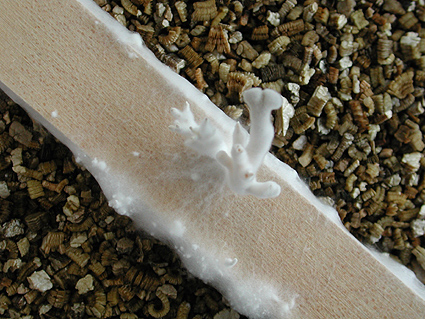Wood-decomposing fungi improve the acoustic properties of wood
Obtaining the perfect violin sound – with fungi
For centuries violin makers have been seeking the perfect sound. Now they have been joined in their quest by Empa's wood researchers. Working in conjunction with the "Master Studio for Violinmaking" in Munich, they are infecting wood with selected species of fungus with the aim of improving its acoustic properties. The first successes have already been achieved and a patent was applied for on 15 June. The fungus-infected violin wood will be on display at the open day in St. Gallen on 18 June.

|
18th-century Stradivarius violins enchant music lovers around the world with their unique sound. Many hypotheses have been put forward to explain the instruments' unique sound: Did Stradivarius, for example, use secret lacquer formulations, primers or mineral compounds? Another theory suggests that the special climatic conditions that prevailed during Stradivarius' "golden era" (1644 to 1737) could be the reason. During the Maunder Minimum, an exceptionally cold period that lasted from 1645 to 1715, trees grew slowly and evenly as a result of the long winters and cool summers. Wood from this period therefore exhibits special material properties, including outstanding tonal quality. Empa's wood researchers have been working with Martin Schleske, a master violin maker and physicist from Munich, to establish how similar acoustic properties can be obtained with the aid of wood-decomposing fungi. Materials science in instrument-making The physical properties of resonant wood have a determining influence on its quality. Low-density wood with a high acoustic velocity and resistance to bending is ideal because it improves the instrument's resonant properties and sound radiation. This is the great advantage of wood compared with other materials such as metal. The acoustic velocity of spruce fir is between 4,800 and 6,200 m/s and its density varies from 320 to 420 kg/m3. In comparison, steel has a similar acoustic velocity, but at 7,000 kg/m3, its density is extremely high. |
||||
|
Fungus-infected wood for violins built by a master The exceptional climatic conditions of the Maunder Minimum cannot, of course, be recreated. However, Empa's researchers have discovered an alternative in the form of wood-decomposing fungi. These nibble at the cell walls, thereby reducing the wood's density – an important requirement for high tonal quality. However, most types of fungus also have the undesirable side effect of decreasing the wood's acoustic velocity and resistance to bending. |
|||
|
The secret is finding a species of fungus that makes the wood less dense without reducing the radiation of sound waves or destroying the solid structure of the wood. A fungus of this type would be ideal for custom manufacturing high-quality wood similar to that used in Stradivarius violins. With this goal in mind, the wood researchers cultivated different species of fungus, infected small, sterilized strips of wood with them and stored the samples in climatic chambers under controlled moist, warm conditions. This process took several months. The fungi proliferated: strangely shaped fruiting bodies grew on the surfaces of the samples and fungus threads pushed deep into the wood. Some of the strips were retrieved from the climatic chambers after four weeks, others after eight or twelve weeks. The residual fungus was then removed before the strips underwent rigorous examination. The scientists measured weight loss, acoustic velocity, resistance to bending and other physical properties in the Empa laboratories. Suitable fungus identified The search for the master fungus was successful. The scientific tests show that several of the chosen wood-decomposing fungus species significantly improved the tonal quality of the wood samples. The results were particularly promising for maple, the wood traditionally used by violin makers for the bottom plates of their instruments. A patent application has already been submitted. The next major challenge is to scale up a process that up to now has only been applied to strips of wood 2.5 cm wide and 10 cm long for larger pieces of wood. It will therefore be another two to three years before the first violin made of fungus-infected wood makes its performance debut. Author Contact |
||||
|
|||

